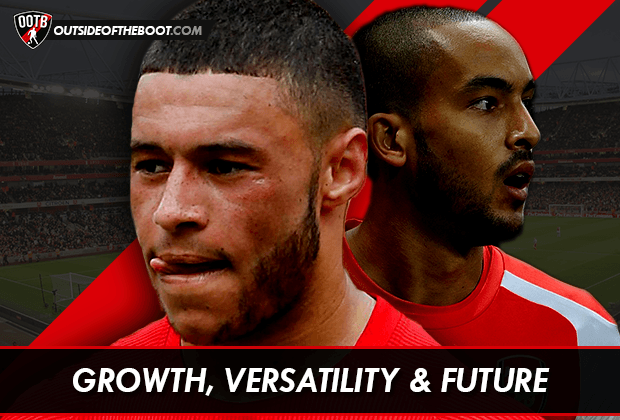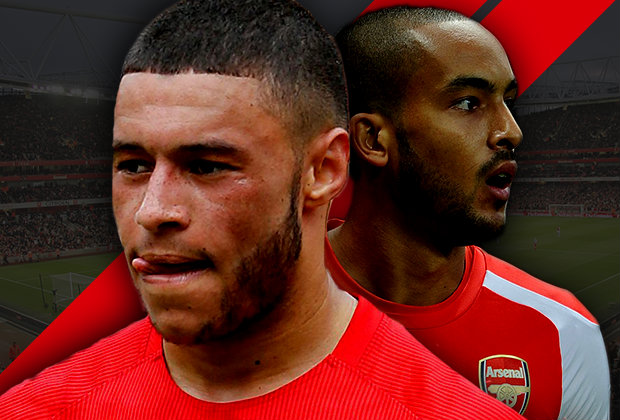Andrew Thompson looks at the careers of Theo Walcott and Alex Oxlade-Chamberlain thus far, and what the future could hold for the duo.

There will never be a moment when you’ll come across an Arsenal supporter and hear them lament the acquisitions of Theo Walcott or Alex Oxlade-Chamberlain. Sure, for years we lauded our youth academy and our dedication to “doing it right”, but a special thanks must be levied south from London to Southampton, who so graciously allowed us to prize the England pair off their youth pipeline for considerable amounts of money.
Walcott and Chamberlain have been two excellent investments from the minute they set foot in London. But how have they gotten to where they are currently, and most importantly, what does the future hold for them? In my opinion at least, it won’t be what we have been accustomed to these past few years.
GROWTH
Theo Walcott’s jet fighter-like pace has been the toast of the town since his youth days on the south coast. I can remember watching clips of him back when I was in university, seeing him blow past his marker like there was no one there, he even had a touch of finishing ability as well. Fast forward to the 2012/2013 Premier League campaign, and it all seemed like Walcott had finally proven himself on the back of 14 goals and 10 assists in 32 league appearances (eight of which saw him come off the bench). It’s noteworthy to consider that was the debut season of Santi Cazorla, who went on to be the clubs player of the year that same season.
The two previous seasons for Walcott were solid as well – 8 goals and 8 assists in 35 appearances in 2011/2012, and 9 goals and 7 assists the prior campaign. All told, 31 goals and 25 assists in 95 appearances over three seasons is nothing to pout about surely, but you would have to consider his progression as a winger to understand that it’s quite possible that his most effective area of deployment wouldn’t be as a winger at all – but we’ll go into that in just a moment.
As for Ox, he’s still just 21 years of age and on current form this season, one of our best performers behind Alexis Sanchez, Santi Cazorla and Laurent Koscielny. His growth has been incredibly fun to watch, perhaps because it’s been somewhat unexpected – not in regards to his quality as a footballer, but how broad his weapons package is. Power, pace, ability on the ball, an eye for a pass, and incredible work rate to track back, Chamberlain is a complete workhorse, despite coming to us in the mould of a speed merchant the same as Walcott.
There is no doubt that Alexis Sanchez is the player of the year thus far, and I don’t mean just for Arsenal either, but one key aspect of the Chilean’s influence at the club is how his efforts motivate those around him. For me, there has been no other player that has soaked up that influence more than Chamberlain, who, in the absence of Walcott and one or two other players, has put in his best season to date since coming to the club. Given that he is four years younger than Walcott, and already putting himself into a position of key importance for both club and country, it’s entirely feasible that in two years time Chamberlain could fully displace Walcott from the starting XI, or worse.
VERSATILITY
When you have the pace of Walcott, it’s a natural instinct for managers to put you on the wing and let you turn on the afterburners. The problem here is that while Walcott has the pace of a wide player, he has the skill-set of a center forward. Everyone may love him, but it may be time to consider something that he himself has openly wanted for quite sometime, and that’s being played through the middle.
In all truth, Walcott has not progressed nearly as much as we all hoped, he’s still that blisteringly quick player who can finish a decent chance, but that’s about as far as his game has come. He’s not the best passer, his control of the ball and ability to beat his market on the dribble is not up to the standard you’d want for a winger, and for the love of god he is awful at trying to put a decent ball into the box from wide areas.
Walcott is hard wired to get into the box and score goals, so why not play him through the middle where the likes of Ozil or Cazorla can provide service to him for 90 minutes? A through ball there, a ball over the top there…name more than three center-backs in England that could keep pace with Walcott at full tilt and I’ll call you a liar, but for me, Walcott at center forward would be a dream.
Back to Ox, and the recognition that he is the poster-boy of versatility for the club at the moment. When Arsene Wenger disclosed that he saw Chamberlain’s future in the middle of midfield, many scoffed at the notion, but is it such an unbelievable notion? Ox is built like a tank, one that happens to be quite quick in his own right. In addition, he’s got the technical ability to go with the power and the pace, and add to the package the newest facet of his game (his ability to pick a pass), and you’ve got a player who can pop up almost anywhere on the pitch.
So far this season, Ox has featured at left wing, right wing, central midfield and holding midfield, and at no time was he sub-par in his performance regardless of where he was. Versatility in football is one of the most sought after attributes of a player, and not only does it make him a prized asset for years to come, but it gives Wenger and his long-term replacement the tactical flexibility in regards to team selection that plays a large part in a successful title challenge.
Naturally I don’t expect you to agree with me or my thoughts and opinion for face value, so I decided to bring some numbers along with me to corroborate what I’ve been discussing – have a look (numbers provided by Squawka.com).
| STATISTICAL CATEGORY | WALCOTT (2012/13) | CHAMBERLAIN (2014/15) |
| Forward Passes | 263 | 405 |
| Key Passes | 28 | 31 |
| Total Passes | 523 | 662 |
| Chances Created | 38 | 32 |
| Shots Inside Area | 60 | 13 |
| Total Shots | 87 | 31 |
| Goals Inside Area | 14 | 1 |
| Total Goals Scored | 14 | 1 |
| Interceptions | 11 | 22 |
| Blocks | 0 | 3 |
| Clearances | 5 | 8 |
| Tackles Won | 15 | 18 |
| Tackles Lost | 10 | 27 |
| Successful Take Ons | 47 | 76 |
| Successful Take Ons % | 43.52% | 66.09% |
| Matches Played (minutes) | 32 (2285) | 21 (1397) |
It’s worth highlighting first that those numbers were compiled from Walcott’s best season at the club, and Chamberlain’s current season, which also happens to be his best as well. It’s also noteworthy to point out that Chamberlain’s numbers are through only 21 matches, 11 fewer than Walcott’s. With that being said, numbers rarely lie, if ever.
Despite playing in far fewer matches in comparison, Chamberlain has far superior passing numbers, defensive numbers, and is the better player on the ball by a country mile. He’s also created only 6 fewer chances despite playing nearly 900 fewer minutes of football.
As for Walcott, there is no disputing that he is the better goal scorer, and with his constant desire to tuck in centrally and feed off service from those around him, it’s no shock at all that he can score that many goals when fully fit. But let me ask you this – would you rather Theo on the wing, or Ox?
FUTURE AT THE CLUB
Currently, even including Walcott, Arsenal only has four wingers: Sanchez, Chamberlain, Walcott and Joel Campbell. Ryo Miyaichi is on loan at FC Twente and likely has no future in London, Serge Gnabry is a long term project but could very well end up back in Germany for all we know, and Lukas Podolski is surely out the door in the summer. As for our strikers, Olivier Giroud, Danny Welbeck and Yaya Sanogo hold reservations at that position, but with the latter out on loan for the rest of the season, youngster Chuba Akpom not yet given a shot at first-team football and Danny Welbeck’s good start to his Arsenal career currently in somewhat of a nose dive, only Giroud stands in Walcott’s way upfront. With Walcott back in the first team & nearly fully fit, and Chamberlain’s form making him un-droppable, now would be the perfect time to see what Walcott can do through the middle, his career could well depend on it.
Consider this for a moment: Walcott at center forward, Ozil or Cazorla behind him as the number 10, with Sanchez and Ox on the flanks. Such a quartet provides pace and work rate on the flanks, creativity in abundance behind the striker, the ability of all three players around the number 10 to roam freely into multiple channels, and a striker in Walcott who is more than willing to continuously get forward and stretch the opposition defense thin. That is not to say that Giroud is not a good striker, but Walcott offers something different than the Frenchman – his pace creates space for others, rather than Giroud who comes deeper and often times takes space away from those supporting him.
Walcott at striker would be a throwback to Arsenal’s counter-attacking past, when Nicolas Anelka and Thierry Henry after him were more than willing to get forward with pace and hit the opposition on the break in mere seconds. When you have that much creativity behind you, you need a striker to capitalize on chances given, not a striker who himself wants to create further.
For me, Walcott’s future has been thrown into a bit of doubt, and the only way to safety is through tactical changes that may not even be on Arsene Wenger’s drawing board. As for Chamberlain, well, when you’re four years younger and already a more complete footballer than your predecessor, your future is all but safely secured.
Written by Andrew Thompson
- 20 Key Young Players to Watch from 20 Premier League Teams - August 10, 2018
- World Cup 2018: Germany Warning Signs - June 20, 2018
- MLS 2017: Top 5 U-22 Players of the Season - December 6, 2017



























































